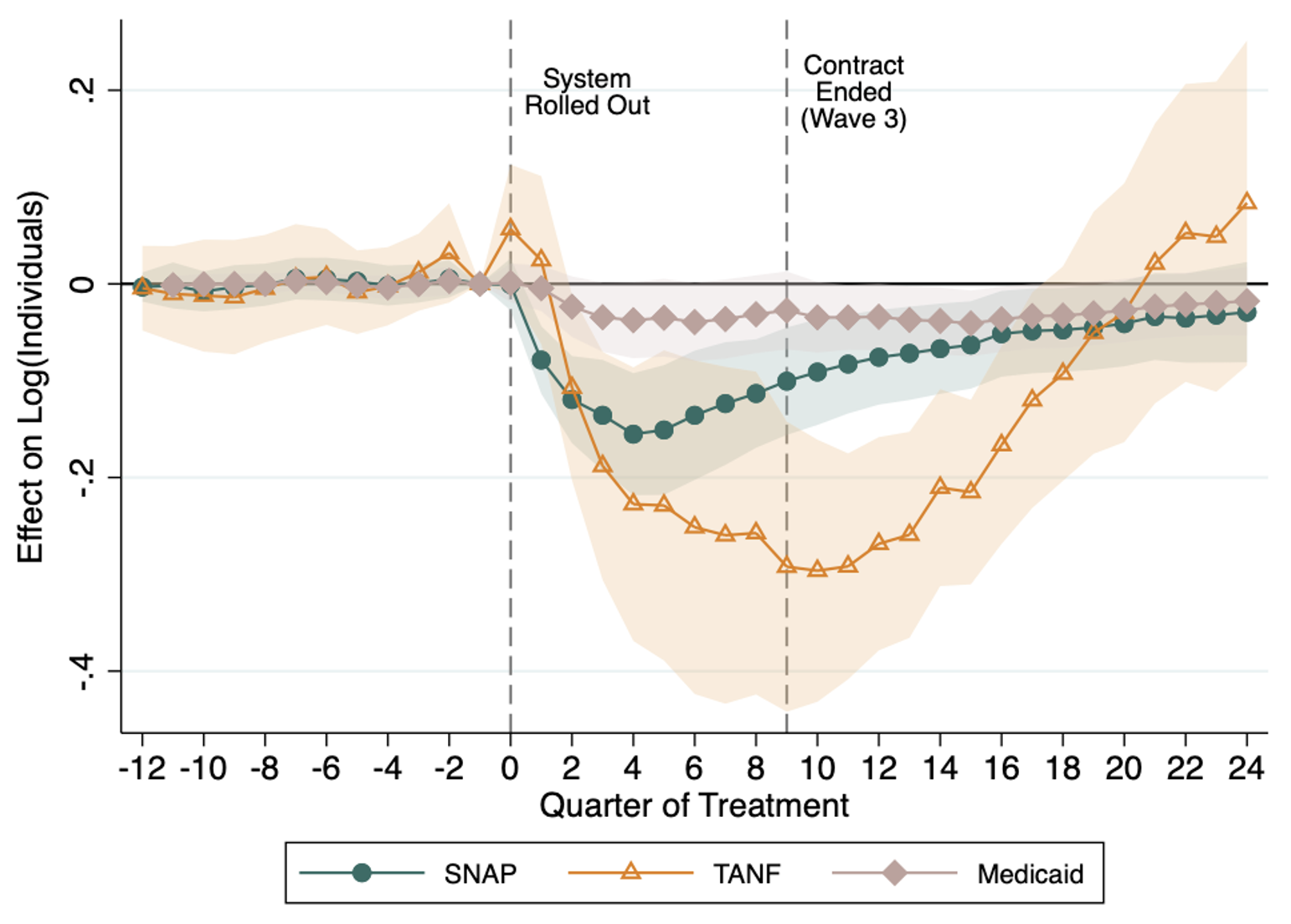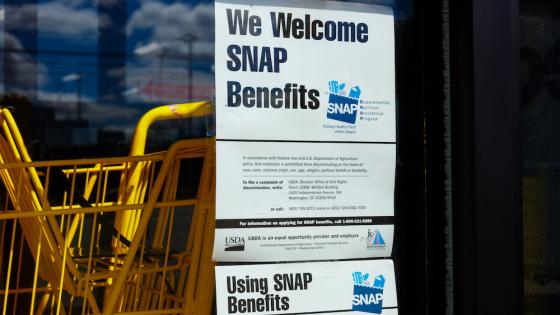Safety net programmes play a crucial role in supporting the livelihoods of many low-income individuals. However, administrative burdens associated with enrollment can prevent eligible individuals from accessing such programmes (Currie 2006, Herd and Moynihan 2018, Moffitt and Ko 2022). The application process can be time-consuming and onerous, leading many well-intentioned applicants to struggle with completion. While these burdens may screen out less needy individuals with a higher opportunity cost of time (Nichols and Zeckhauser 1982, Besley and Coate 1992), understanding why needy applicants are not enrolled is crucial for ensuring the effectiveness of these programmes (Mullainathan and Shafir 2013).
The effects of administrative burdens can hinge critically on the context in which they appear. A given set of burdens, for example, may have different effects across programmes based on differences in their enrollment procedures or populations served. Within a programme, burdens can also appear at multiple points throughout the application and recertification process. Despite the importance of these programmes, little is known about how administrative burdens and their consequences differ across programmes and application stages.
In a recent paper (Wu and Meyer 2023), we address this gap by investigating how barriers to enrollment affect the take-up of three important safety net programmes in the US – the Supplemental Nutrition Assistance Program (SNAP), Medicaid, and Temporary Assistance for Needy Families (TANF).
Importantly, we examine the types of individuals who are screened out at a given application stage. We analyse administrative burdens associated with the automation of welfare caseworker assistance, which states have increasingly adopted to allow individuals to apply and recertify remotely – a phenomenon that only accelerated further during the COVID-19 pandemic. Automation is usually thought to provide greater convenience for applicants, but it can also lead to greater inflexibility and an inability to tailor services to individual circumstances.
Our research setting is the state of Indiana, which in 2007 awarded a ten-year, $1.3 billion contract to the IBM Corporation to automate caseworker assistance for the state’s welfare services. IBM used online and phone platforms to replace face-to-face interactions with local caseworkers, resulting in a lack of personalised assistance, lower tolerance for errors, and long wait times at overwhelmed call centres. While the automated system was rolled out in phases beginning in late 2007, it was terminated just two years later after reaching only 59 out of Indiana’s 92 counties. By facilitating a comparison of outcomes over time between those counties receiving the rollout (treated areas) and all other counties (untreated areas), this natural experiment enables the identification of a causal effect. Using administrative welfare records covering nearly 3 million recipients, we develop a framework to compare the effects of barriers to enrollment on take-up and targeting among initial applicants and those recertifying their eligibility.
Our results show considerable declines in SNAP (15%), TANF (24%), and Medicaid (4%) enrollments one year after the rollout of IBM’s automated system (Figure 1). All three programmes experienced similar reductions in entry rates, while the increases in exit rates were largest for TANF and smallest (and statistically insignificant) for Medicaid. The larger response for TANF can be attributed to higher transaction costs associated with shorter TANF recertification intervals and fewer avenues from application assistance (vice-versa for Medicaid). For Medicaid, the overall enrollment reduction also exhibited considerable permanence: four years after the automated system was disbanded (and six years after the initial rollout), enrollment in treated counties remained 2% lower than in untreated counties. At the county level, proportional enrollment reductions were largest in earlier-treated and higher-poverty counties, as well as in lower-unemployment counties whose residents may have had more earnings to verify.
Figure 1 Effects of IBM’s automated system on enrollment in SNAP, TANF, and Medicaid
In analysing who is affected by IBM’s automated system, we find that those remaining on the programme rolls have lower pre-treatment incomes, fewer years of education, higher per-person benefits, and higher disability levels – suggesting that less needy individuals tend to be screened out on average. However, these overall effects conceal striking differences across application stages. Specifically, less needy individuals are screened out at entry while more needy individuals are screened out at exit. These empirical results can be rationalised by a model in which administrative burdens screen out both the least and most needy individuals, with the former more likely to appear at initial application and the latter more likely to appear at re-certification (due to differential selection of individuals into each stage).
Our study offers a potential explanation for the conflicting results in prior empirical studies on targeting effects of application costs (e.g. Alatas et al. 2019, Deshpande and Li 2019, Gray 2019, Shepard and Wagner 2021, Unrath 2021). These studies typically examine changes only along a single margin (initial take-up or retention), but we explicitly show that targeting effects can differ across entry and exit. Indeed, Finkelstein and Notowidigdo (2019), find that SNAP application costs lead to improved targeting when studying initial applicants, while Homonoff and Somerville (2021) find the opposite result when studying SNAP re-certifiers.
More generally, our paper shows that the move towards automating the role of caseworkers introduces the possibility of unintended consequences. The increasing shift towards remote determinations of eligibility for government programmes has come on the heels of caseworkers seeing their roles diminish over time in response to perceived inefficiencies and complaints about fraud. Research has shown that caseworkers play an important role in a variety of settings (Cook and East 2023, Matheson et al. 2023), and we further demonstrate that human contact (or the lack thereof) can have different effects at different stages – depending on the types of clients appearing at a given stage. Consequently, policymakers may be well-advised to adapt procedures differentially across stages and programmes to improve how well they reach their intended population.
Finally, the natural experiment setting and groundbreaking data sources in our paper can be further used to examine whether welfare cuts induce individuals to increase their short-run labour supply and potentially induce greater self-sufficiency in the long run. One can also examine the extent to which individuals turn to other forms of insurance as a result of sharp negative income shocks. These additional analyses could provide more direct evidence on the mechanisms underlying the long-term effects on SNAP and Medicaid enrollment identified in this paper, that persist beyond the life of IBM’s automated system.
References
Alatas, V, A Banerjee, R Hanna, B A Olken, R Purnamasari, and M Wai-Poi (2016), “Self-Targeting: Evidence from a Field Experiment in Indonesia”, Journal of Political Economy 124(2): 371-427.
Besley, T and S Coate (1992), “Workfare versus Welfare Incentive Arguments for Work Requirements in Poverty-Alleviation Programs”, American Economic Review 82(1): 249-261.
Cook, J B and C N East (2023), “The Effect of Means-Tested Transfers on Work: Evidence from Quasi-Randomly Assigned SNAP Caseworkers”, NBER Working Paper No. 31307.
Currie, J (2006), “The Take-Up of Social Benefits”, in A Auerbach, D Card, and J Quigley (eds), Public Policy and the Income Distribution, Russell Sage Foundation.
Deshpande, M and Y Li (2019), “Who Is Screened Out? Application Costs and the Targeting of Disability Programs”, American Economic Journal: Economic Policy 11(4): 213-248.
Finkelstein, A and M J Notowidigdo (2019), “Take-Up and Targeting: Experimental Evidence from SNAP”, Quarterly Journal of Economics 134(3): 1505-1556.
Gray, C (2019), “Leaving Benefits on the Table: Evidence from SNAP”, Journal of Public Economics 179(C): 1-15.
Herd, P and D Moynihan (2018), Administrative Burden: Policymaking by Other Means, Russell Sage Foundation.
Homonoff, T and J Somerville (2021), “Program Recertification Costs: Evidence from SNAP”, American Economic Journal: Economic Policy 13(4): 271-298.
Moffitt, R and W Ko (2022), “Take-Up of Social Benefits”, VoxEU.org, August 24.
Matheson, J, M Koppensteiner, and R Plugor (2023), “Reducing Barriers to Support Services in Domestic Violence Cases Leads to More Effective Use of Police Services”, VoxEU.org, May 12.
Mullainathan, S and E Shafir (2013), Scarcity: Why Having Too Little Means So Much, Times Books, Henry Holt and Company.
Nichols, A L and R J Zeckhauser (1982), “Targeting Transfers through Restrictions on Recipients”, American Economic Review 72(2): 372-377.
Shepard, M and M Wagner (2021), “Reducing Ordeals through Automatic Enrollment: Evidence from a Subsidized Health Insurance Exchange”, Working Paper.
Unrath, M (2021), “Targeting, Screening, and Retention: Evidence from California's Food Stamps Program”, Working Paper.
Wu, D and B D Meyer (2023), “Certification and Recertification in Welfare Programs: What Happens When Automation Goes Wrong?”, NBER Working Paper No. 31437.




